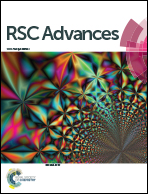Facile synthesis of well-defined linear-comb highly branched poly(ε-caprolactone) using hydroxylated polybutadiene and organocatalyst
Abstract
A series of linear-comb highly branched poly(ε-caprolactone) (LC-PCL) with well-defined structure, high molecular weight and narrow polydispersity was synthesized using hydroxylated polybutadiene as macroinitiator and 1,5,7-triazabicyclo-[4.4.0]dec-5-ene (TBD) as catalyst at room temperature. First, the macroinitiator, functionalized hydroxylated polybutadiene was prepared by anionic polymerization of butadiene, epoxidation and ring-opening reaction. Then the hydroxyl groups in the hydroxylated polybutadiene initiated the ring-opening polymerization of ε-caprolactones in the presence of TBD. In an effort to optimize the reaction system, the effects of different reaction factors on the ring-opening polymerization were investigated. The simplicity of the reaction conditions, the ready availability of the catalyst, and the exquisite control over the polymerization were also demonstrated. The arm number, side chain length, and molecular weight of branched LC-PCL were regulated by adjusting the number of hydroxyl groups on macroinitiator and monomer/hydroxyl group feed ratios. Physical properties (thermal property, crystal structure and spherulitic morphology) of the obtained polymers were analyzed by DSC, TGA, WAXD and POM. The results showed that the branched PCL crystallize in the ordinary crystal form similar to linear PCL, and the crystallization and melting behaviors are strongly dependent on the side PCL chain length.


 Please wait while we load your content...
Please wait while we load your content...